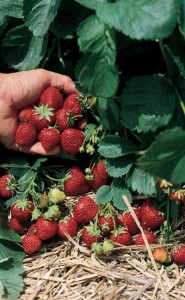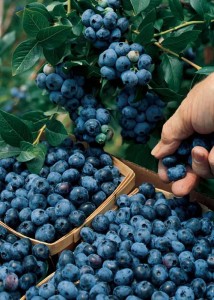You normally think of summer when you read the word “berries,” right? June brings ripe strawberries, July gives us raspberries and blackberries and the tail-end of summer brings blueberry picking.
While u-pick berries are fun to gather and it’s always refreshing to find fresh berries at farmers markets, berries can be grown at home, too. Here’s the scoop on growing strawberries, blueberries, blackberries and raspberries in your home Ohio garden:
Strawberries

Planting requirements
Location: Well-draining location, or in raised beds or on a ridge if drainage is a problem; Don’t plant strawberries near where tomatoes, potatoes or sod have been recently grown in order to avoid some insect problems and plant diseases
Soil type: Somewhat acidic (pH between 5.8 and 6.5); well-drained, loose, fertile soil
Sun: Full sun
Planting: In the spring, when soil isn’t too wet; roots and only half of the crown should be covered with soil; roots must be set vertically in a deep trench
Spacing for June-bearing: 12-24 inches apart; by August, 6-8 plants should be in each row; each row should be 18-24 inches wide and there should be 36-40 inches between rows
Spacing for everbearing: 8-12 inches apart; 30-36 inches between rows; flowers should be removed for the first six weeks; a few inches of wood or straw mulch should be put down to help with moisture and weed control.
Watering: 1 to 1.5 inches of water each week from mid-June to mid-August. The soil shouldn’t remain soggy.
Other requirements: During the first year of growth, remove flowers so plants become more vigorous.
For information about after-harvest care, frost protection and other issues related to growing strawberries, see OSU Extension’s Midwest Home Fruit Production Guide.
Blueberries

Planting requirements
Location: well drained, preferably in a location with a north slope or north side of a wind break; site should be clear of debris and grass before tilling
Soil type: pH between 4.5 and 5; sulfur may be needed to lower the soil pH; sandy or loam soil; moist soil
Sun: Full sun
Planting: Dormant plants can be planted in the spring; Hole for each root system should be 2-3 times larger; a gallon of peat or sphagnum moss can be added to the hole
Spacing: Allow 4 feet between highbush blueberries
Watering: Don’t allow blueberry bushes to wilt; During blossoming, provide supplemental watering, fruit ripening and fall flower bud development; Once mature, provide 1-2 inches of water every 10 days from rainfall or supplemental watering
Other requirements: 4-6 inches of sawdust and wood chips can be used as mulch; keep a 3-inch circumference around the base of the bush free from mulch so the stems aren’t damaged; prune blueberries late winter through bud break
Additional information about blueberry cultivars and pruning requirements, see OSU Extension’s Midwest Home Fruit Production Guide.
Blackberries and raspberries

Planting requirements
Location: Away from frost pockets; on a north slope or the north side of a wind break; don’t plant where tomatoes, potatoes or eggplants have recently been planted so that plant diseases don’t affect the brambles
Soil type: Soil pH 5.8 to 6.5; use a soil test to determine soil pH; raspberries can grow in several soil types
Sun: Full sun
Planting: Debris and grass should be cleared before tilling; plant in early spring; dig hole 1.5 times larger than root mass
Spacing: Each type of bramble requires specific spacing:
- Red and yellow raspberry: 2 feet between plants and 10 feet between rows; plant in hedgerow on low trellis
- Black raspberry: 2.5 feet between plants and 10 feet between rows; plant linear with low trellis
- Erect blackberry: 3 feet between plants and 10 feet between rows; plant linear without trellis
- Purple raspberry: 3 feet between plants and 10 feet between rows; plant linear without trellis
- Trailing (thornless) blackberry: 6-8 feet between plants and 12 feet between rows; plant linear with high trellis
Watering: 1 to 1.5 inches of water per week is needed 10 days from rainfall or supplemental watering; If soil is loamy or sandy, water more; Supplemental watering is necessary during blossoming, fruit ripening and fall flower bud development; Watering fruit or foliage could cause diseases infection
Other requirements: 2-3 inches of shredded leaves, straw, sawdust or another type of mulch can be added for weed and moisture control
Each blackberry or raspberry cultivar may require specific care. See OSU Extension’s Midwest Home Fruit Production Guide for information on cultivars typically grown in Ohio.
Plant in the fall
Farm and Dairy online columnist Ivory Harlow recommends planting fruit in the fall, depending on your location and the type of fruit you want to plant. If you live in Hardiness Zones 6 to 10, you shouldn’t have a problem getting fruit started in the cooler months. Most of Ohio is in Hardiness Zone 6a or 6b, but portions of some counties (like Knox, Richland, Ashland, Ashtabula, Geauga and others).
The advantages to planting berries in the fall are taking advantage of active root growth, avoiding summer heat stress and moisture control.
More about berries
- Everything you wanted to know about sustainable strawberries in an e-book Nov. 15, 2014
- Blueberries profitable option in Ohio June 7, 2013
- Blackberries can increase farm profits: Learn how at Farm Science Sept. 17, 2013
- Blackberries a bright spot for Ohio June 18, 2008
- Raise raspberries right June 29, 2009
- Raspberries: A small fruit that yields big opportunities June 11, 2008
Source: Ohio State University Extension


















You state you shouldn’t have trouble planting in Ohio in 6a and b in fall, but is in Ashland, Richmond ??? then what you drop it there. Are they warmer or colder? Medina is zone 5 supposedly.